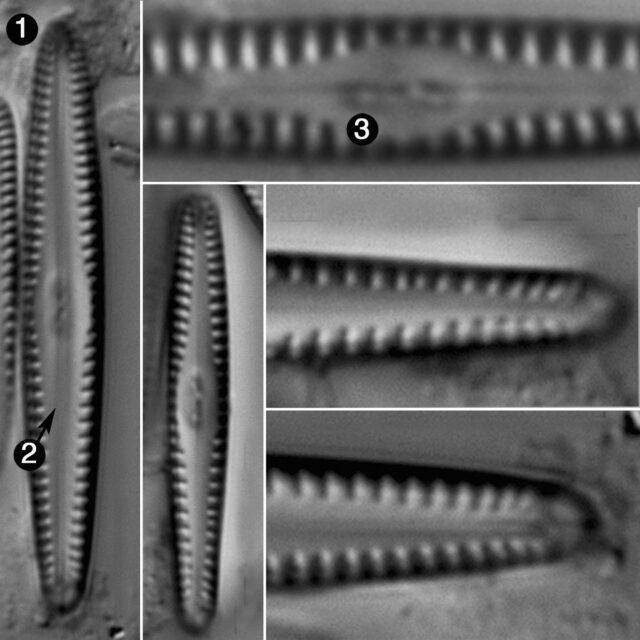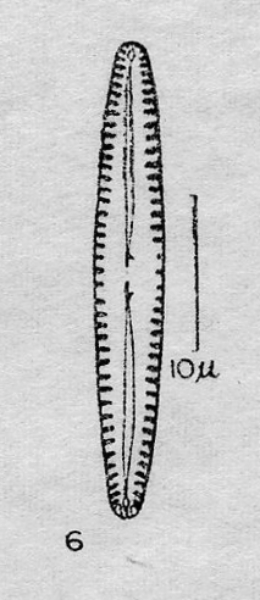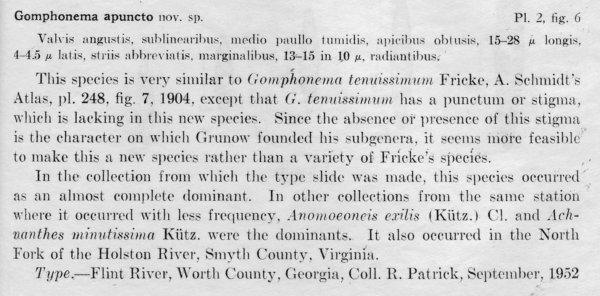Gomphonema apuncto
-
Category
-
Length Range21.0-30.7 µm
-
Width Range3.0-4.1 µm
-
Striae in 10 µm13-16
-
ContributorMeredith Tyree Polaskey, Melissa Vaccarino - Sep 2016
-
ReviewerMarina Potapova - Mar 2017
Identification
View image metadata
Type
Description
Valves are nearly linear, with a rounded headpole and narrowly rounded footpole. The axial area is lanceolate and relatively broad. A stigmoid is absent. The raphe is lateral and straight. The external proximal raphe ends are expanded and are placed close to one another. The external distal raphe ends are deflected in the same direction. The internal proximal raphe ends are sharply recurved and distinct. The central nodule is thickened and distinct. Striae are radiate, becoming nearly parallel at the headpole and more strongly radiate at the footpole.
The specimens shown here are from the type slide. Gomphonema apuncto appears to be a rare taxon, restricted to rivers of the southeast states. Many of the records of G. apuncto appear to be misidentifications. This taxon may be confused with small valves of G. christenseni and perhaps other, as yet undescribed, species.
Autecology
Gomphonema apuncto appears to be a rare taxon in rivers, restricted to the southeast states. In the original description (Wallace 1960), it was described from the Flint River, Georgia. That publication also reported it from the North Fork of the Holston River, Smyth County, Virginia.
-
Size Range, µm3
-
Motility
-
Habitat
-
Colony
-
Occurrence
-
Waterbody
- Learn more about this
Original Description
Gomphonema apuncto nov. sp.
Valvis angustis, sublinearibus, medio paullo tumidis, apicubus obtusis, 15-28, μ longis, 4-4.5 μ latis, striis abbreviatis, marginalibus, 13-15 in 10 μ, radiantibus.
This species is very similar to Gomphonema tenuissimum Fricke, A. Schmidt's Atlas, pl. 248, fig. 7, 1904, except that G. tennuissimum has a punctum or stigma, which is lacking in this species. Since the absence or presence of this stigma is the character on which Grunow founded his subgenera, it seems more feasible to make this a new species rather than a variety of Fricke's species.
In the collection from which the type slide was made, this species occurred as an almost complete dominant. In other collections from the same station where it occurred with less frequency, Anomoeoneis exilis (Kütz.) Cl. and Achnanthes minutissima Kütz. were the dominants. It also occurred in the North Fork of the Holston River, Smyth County, Virginia.
Type.--Flint River, Worth County, Georgia, Coll. R. Patrick, September, 1952
-
AuthorJ.H.Wallace 1960
-
Length Range15-28 µm
-
Width4-45 µm
-
Striae in 10µm13-15
Citations & Links
Links
-
Index Nominum Algarum
Cite This Page
Polaskey, M., Vaccarino, M. (2016). Gomphonema apuncto. In Diatoms of North America. Retrieved April 25, 2024, from https://diatoms.org/species/gomphonema_apuncto
Responses
The 15 response plots show an environmental variable (x axis) against the relative abundance (y axis) of Gomphonema apuncto from all the stream reaches where it was present. Note that the relative abundance scale is the same on each plot. Explanation of each environmental variable and units are as follows:
ELEVATION = stream reach elevation (meters)
STRAHLER = distribution plot of the Strahler Stream Order
SLOPE = stream reach gradient (degrees)
W1_HALL = an index that is a measure of streamside (riparian) human activity that ranges from 0 - 10, with a value of 0 indicating of minimal disturbance to a value of 10 indicating severe disturbance.
PHSTVL = pH measured in a sealed syringe sample (pH units)
log_COND = log concentration of specific conductivity (µS/cm)
log_PTL = log concentration of total phosphorus (µg/L)
log_NO3 = log concentration of nitrate (µeq/L)
log_DOC = log concentration of dissolved organic carbon (mg/L)
log_SIO2 = log concentration of silicon (mg/L)
log_NA = log concentration of sodium (µeq/L)
log_HCO3 = log concentration of the bicarbonate ion (µeq/L)
EMBED = percent of the stream substrate that is embedded by sand and fine sediment
log_TURBIDITY = log of turbidity, a measure of cloudiness of water, in nephelometric turbidity units (NTU).
DISTOT = an index of total human disturbance in the watershed that ranges from 1 - 100, with a value of 0 indicating of minimal disturbance to a value of 100 indicating severe disturbance.

Gomphonema apuncto
- Valves narrow, linear
- Axial area wide
- Stigmoid absent
- Valves 3.0-4.1 µm wide
Valves are narrow and linear, 3.0 - 4.1 µm in width. The axial area is relatively wide. A stigmoid is absent.
 Diatoms of North America
Diatoms of North America





